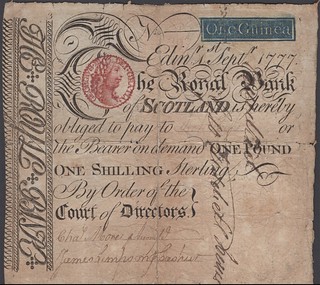
PREV ARTICLE
NEXT ARTICLE
FULL ISSUE
PREV FULL ISSUE
V25 2022 INDEX E-SYLUM ARCHIVE 1777 SCOTLAND TRI-COLOURED BANKNOTEI didn't manage to get this into our last issue, and missed the sale date. But this Noonan's press release discusses an interesting historical banknote. -Editor
Scotland's attempt to monopolise the Atlantic to Pacific trade route across Panama ended in the Darien disaster of the 1690s. It cost the Scots around 20% of their circulating wealth and was a major factor leading to the 1707 Act of Union with England, which agreed to bail out the losses. The company formed to manage the payments realised it had money over to invest and petitioned the king for approval to start a bank. In 1727 a royal charter duly allowed the establishment of the Royal Bank of Scotland. The existing Bank of Scotland's trading monopoly had already lapsed, creating the opportunity for the new Royal Bank to expand. However, instability, especially because of the 1745 Jacobite uprising, made this difficult. Eventually, as Edinburgh became the centre of the Enlightenment, the bank prospered, opening its first branch office, in Glasgow, in 1783, to help fund investment in the city's burgeoning port and factories. Six years before this initial expansion took place, the bank issued a One Guinea note, signed by two directors of the Royal Bank of Scotland. Charles Moore and James Simpson. Dated 1st September 1777 and carrying the serial number 857/297, it promised to pay Archibald Hope the sum listed on production of the note. Hope was probably Sir Archibald Hope 9th Baronet (1735-94) who established the family seat at Pinkie House in Musselburgh, Edinburgh in 1778.
For more information, see:
Wayne Homren, Editor The Numismatic Bibliomania Society is a non-profit organization promoting numismatic literature. See our web site at coinbooks.org. To submit items for publication in The E-Sylum, write to the Editor at this address: whomren@gmail.com To subscribe go to: https://my.binhost.com/lists/listinfo/esylum All Rights Reserved. NBS Home Page Contact the NBS webmaster 
|
